HK art galleries are open for business again. Tai Kwun Contemporary is back with two new art exhibitions — including one on the timely theme of confinement. Chitralekha Basu reports.
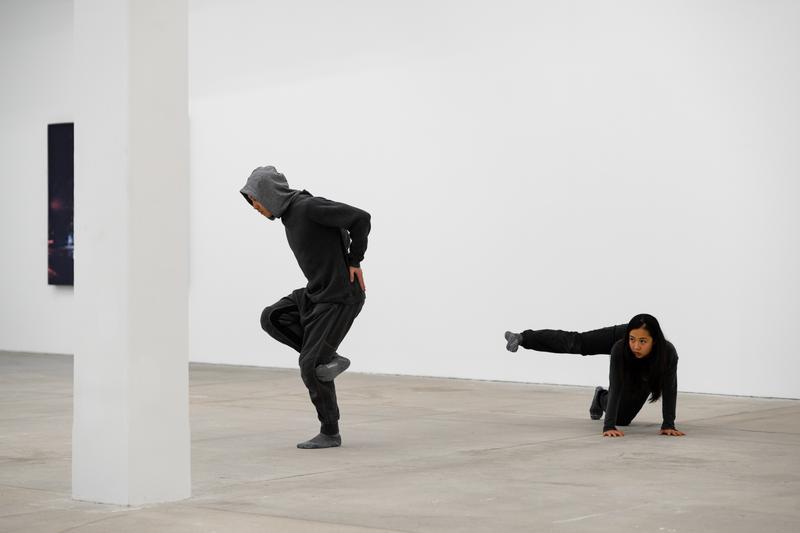 Eisa Jocson’s performance piece Manila Zoo investigates the commonalities between human and animal behavior at a time when more people are staying indoors than out. (PHOTO PROVIDED TO CHINA DAILY)
Eisa Jocson’s performance piece Manila Zoo investigates the commonalities between human and animal behavior at a time when more people are staying indoors than out. (PHOTO PROVIDED TO CHINA DAILY)
Fittingly, one of the two exhibitions launched to mark the reopening of Tai Kwun Contemporary on May 25 explores the idea of being boxed in. Much of humanity has experienced the feeling of being sequestered in their own unique ways in the last few months, since the outbreak of the novel coronavirus. My Body Holds Its Shape, featuring new works taking off from the theme of incarceration, is thus likely to resonate widely, if not universally.
The show is set in F Hall of JC Contemporary building in Tai Kwun — a prison complex that was decommissioned in 2006 and has since been adapted into a cultural space and opened to the public two years ago. F Hall used to be a printing facility, and later, a female ward of the prison. Curated by Xue Tan, My Body Holds Its Shape re-imagines the site in which it is located — a sprawling 2,100-square feet white cube art gallery — as both limiting and liberating, or rather, tries to find the spirit of freedom embedded in a space that was created to confine and control prisoners.
 Ho Tzu Nyen’s Earth is a spectacular video installation, paying homage to a range of classical European Renaissance paintings. Now on show at Tai Kwun Contemporary. (PHOTO PROVIDED TO CHINA DAILY)
Ho Tzu Nyen’s Earth is a spectacular video installation, paying homage to a range of classical European Renaissance paintings. Now on show at Tai Kwun Contemporary. (PHOTO PROVIDED TO CHINA DAILY)
A part of the wall at one end of the hall has been dramatically removed and replaced with glass panels, fortified by a steel frame, revealing a corridor with three windows, framing the scenery outside like a set of paintings. The piece, playfully titled pullherawaypull, is by Thea Djordjadze, a Berlin-based Georgian artist. Her other contributions to the show include an equally quirky set of three sleek angular metallic sculptures vaguely resembling two benches and a foldable table but keep changing shape, and purpose, depending on the observer’s point of view.
Also by Djordjadze is a set of two tall and narrow steel vitrines, propped up against the wall. While their cage-like appearance serves as a throwback to the idea of imprisonment that F Hall has been witness to, back in the day, for this show they have been re-purposed as photo display boxes.
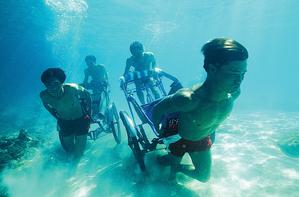 Jun Nguyen Hatsushiba’s video offers a surreal take on the plight of the Vietnamese boat people. (PHOTO PROVIDED TO CHINA DAILY)
Jun Nguyen Hatsushiba’s video offers a surreal take on the plight of the Vietnamese boat people. (PHOTO PROVIDED TO CHINA DAILY)
The steel cages contain a set of four photographs taken by Thai artist Pratchaya Phinthong. At first glance the images could be mistaken for glimpses of the sky, taken from inside a cave or dormant volcano. They are in fact chunks of meteorites, reflecting the sky on their shiny surface — a fine example of the life-affirming elements that often lie hidden where they are least expected.
Arguably the most striking piece in the show is Phinthong’s sculpture, Fork. It’s a slab of lead made with the remains of unexploded ordnance retrieved from the farmlands in Laos. Polished and shining like a mirror on one side and left rough and hewn on the other, the piece is mounted vertically. It’s roughly the same height as a human being’s, standing like a mute witness, as it were, to the heavy US-bombing during the Vietnam War (1955—1975).
 Curator Xue Tan designed My Body Holds Its Shape around the theme of limits, hoping to inspire greater empathy in viewers. (PHOTO PROVIDED TO CHINA DAILY)
Curator Xue Tan designed My Body Holds Its Shape around the theme of limits, hoping to inspire greater empathy in viewers. (PHOTO PROVIDED TO CHINA DAILY)
Hong Kong artist Tap Chan’s contribution to the show is so understated it might be easy to miss. Titled Speed of Night, Chan’s piece comprises white poles with hand-painted spiralling stripes inserted in the wall. While automated hair salon signage comes to mind, the spare look of the poles, near-invisible against the walls, and their ponderously slow turning make the installation something of an antithesis of the often loud and garish graphics generated by their salon counterparts.
Berlin-based American artist Jason Dodge has created an installation comprising two companion pieces that might look like stacked up woven fabric, bound in strings. The total length of jute fiber thread that went into making each of these “equals the distance from the earth to above the weather.” Tan Zhixiang, from Liuyang, China chose to weave one of the two pieces in black, whereas participants from Hong Kong’s St James’ Creation — the creative wing of St James’ Settlement, a charity that helps rehabilitate people with special needs — wove the other one using yarns dyed in the most vivid shades of blue, yellow, red and brown, articulating the feelings that often remain locked up inside people on the autism spectrum.
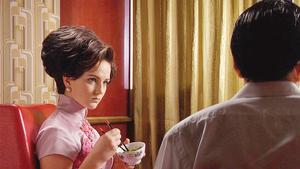 Ming Wong’s video installation tweaks a scene from Wong Kar-wai’s In the Mood for Love by having a Caucasian actress replace the Chinese romantic pair. (PHOTO PROVIDED TO CHINA DAILY)
Ming Wong’s video installation tweaks a scene from Wong Kar-wai’s In the Mood for Love by having a Caucasian actress replace the Chinese romantic pair. (PHOTO PROVIDED TO CHINA DAILY)
Odds and ends
The second exhibition at Tai Kwun this season features old and new works by eighteen artists contributed by the National Museum of Art, Osaka and Singapore Art Museum. The show, called They Do Not Understand Each Other, experiments with putting disparate elements in the same space and looks for meanings in the interstices.
The show is named after a video installation by Tsubasa Kato, in which two men from Japan and Korea who are strangers to each other meet in Tsushima Islands, equidistant from both Korea and the Japanese mainland. They do not speak a word of each other’s language, but manage to plant a signpost together. Having failed to communicate verbally, one of them climbs on the other’s shoulders to hammer the staff into the ground. It’s a telling image of bonding across languages, nationalities and cultures. The connection thus made is both effective and awkward.
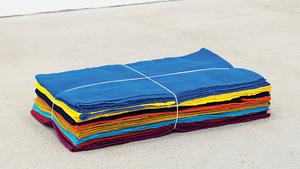 Members of Hong Kong’s St James’ Creation used yarns in vivid colors to weave a part of Jason Dodge’s installation piece. (PHOTO PROVIDED TO CHINA DAILY)
Members of Hong Kong’s St James’ Creation used yarns in vivid colors to weave a part of Jason Dodge’s installation piece. (PHOTO PROVIDED TO CHINA DAILY)
There are more pieces in the show underscoring the complicated, potentially-unsettling nature of cultural encounters. Ming Wong’s three-channel video, In Love for the Mood, tweaks a scene from Hong Kong director Wong Kar-wai’s classic film, In the Mood for Love. The Chinese actors in the original version are replaced by a Caucasian actress who plays both the male and female leads, visibly ill-at-ease with playacting and struggling with her Cantonese.
Jun Nguyen-Hatsushiba’s single-channel video captures enchanting footage of Vietnamese men pulling rickshaws on a sun-lit sea bed, surfacing above the water from time to time to fill their lungs with water, alluding to the plight of the displaced boat people of that country. In Ho Tzu Nyen’s video Earth, the camera pans across an enormous cast of characters, as if to capture and illuminate details of a painting resembling a scene set in a theater by turns. The composition and manipulation of light and darkness is very Rembrandt. Inter-textual references abound, with a nod to Theodore Gericault’s The Raft of the Medusa and Caravaggio’s The Incredulity of Saint Thomas among several others.
 Wit Pinkanchanapong’s towering metallic sculpture is both mysterious and alluring, like a modern-day totem pole. (PHOTO PROVIDED TO CHINA DAILY)
Wit Pinkanchanapong’s towering metallic sculpture is both mysterious and alluring, like a modern-day totem pole. (PHOTO PROVIDED TO CHINA DAILY)
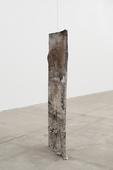 Pratchaya Phinthong’s Fork is made from unexploded ordnance from the Vietnam War found in the fields of Laos. (PHOTO PROVIDED TO CHINA DAILY)
Pratchaya Phinthong’s Fork is made from unexploded ordnance from the Vietnam War found in the fields of Laos. (PHOTO PROVIDED TO CHINA DAILY)
My favorite from the show is Wit Pimkanchanapong’s Not Quite A Total Eclipse — a towering metallic sculpture with a single light bulb inside. Hundreds of motorized rotating blades cast steadily-morphing shadows on the wall, turning the room in which the piece is installed into a giant kaleidoscope. A bit like a totem pole for the modern age, its rhythms come across as highly mysterious, spurring one’s curiosity as to if the constantly turning blades can ever align to create a total eclipse or light up the room without a shadow.
If you go
My Body Holds Its Shape
Curated by Xue Tan
Date: Until September 2020
They Do Not Understand Each Other
Curated by Yuka Uematsu and June Yap
Date: Until Sept 13, 2020
Venue: JC Contemporary, Tai Kwun Centre for Heritage and Arts, 10, Hollywood Road Central
Contact the writer at basu@chinadailyhk.com


